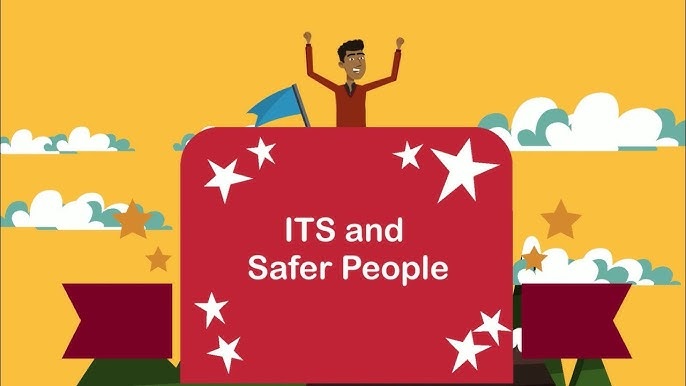USDOT
As another school year begins, I think back to when my own children were young, and cautioning them to look both ways before crossing the street. With even more vehicles on the roads and pedestrian crashes on the rise, that advice is more important than ever. But equally important is understanding that we all share responsibility for pedestrian safety, including every planner, designer, builder, operator, and user of our transportation system.

The idea of shared responsibility is central to the safe system approach, which considers such elements as people, speeds, roads, vehicles, and post-crash care. This October, which is National Pedestrian Safety Month, the US Department of Transportation is emphasizing the safe system approach and boosting its efforts to improve safety for vulnerable road users. Everyone deserves to be safe while walking or rolling on our streets.
At the Intelligent Transportation Systems Joint Program Office (ITS JPO), we are always working to improve pedestrian safety. One example is the ITS4US Deployment Program, a $40 million, multimodal effort to address mobility challenges for all travelers with a specific focus on underserved communities. The program includes four projects led by the University of Washington (UW), the Georgia Department of Transportation (GDOT), the Niagara Frontier Transportation Authority (NFTA), and the Heart of Iowa Regional Transit Agency (HIRTA). The UW and GDOT projects focus heavily on pedestrian safety.
At UW, the Transportation Data Equity Initiative (TDEI) is deploying advanced technologies to map sidewalks, crosswalks, and other pedestrian pathways on a national scale. The effort began in Maryland, Oregon, and Washington, but has since expanded through new partnerships to California, New York, North Carolina, and cities across the globe. The initiative has developed an open-source data sharing system to standardize information about ramps, curbs, and other features of the pedestrian and bicycle transportation network. Third-party providers can use this system to build applications that help travelers find the route that is best for them. Planners, businesses, and other stakeholders can also use the data to design and build communities that are more accessible to everyone.
GDOT's ITS4US deployment similarly focuses on pedestrian accessibility and safety. GDOT and its partners are developing a mobile application, the Georgia Mobility and Accessibility Planner (G-MAP), to enhance transportation for underserved communities, including people with disabilities, older adults, and travelers with limited English proficiency. Users will be able to create a personalized trip plan that is tailored to their needs. Along the way, the application will interface with transit services, broadcast safety messages to connected vehicles, automate extended crosswalk times, and more. The current deployment serves Gwinnett County, Georgia, but the open-source application is designed to be scalable and replicable.
If you are interested in learning more about the UW and GDOT deployments, be sure to register for the upcoming ITS4US webinar on Thursday, October 24, at 2 p.m. The session will explore innovative methods for collecting and digitizing sidewalk data to enhance pedestrian safety, mobility, and access.
Two other ITS4US deployments are also addressing mobility challenges for all travelers. In Buffalo, New York, NFTA is deploying an integrated set of travel support services and systems in the neighborhoods surrounding a large medical campus. In Dallas County, Iowa, HIRTA is developing an application to improve transportation to healthcare for underserved populations and their caregivers. The HIRTA project recently passed a major milestone, moving from design and testing (phase 2) to operations and evaluation (phase 3).
Vehicle-to-everything (V2X) technology is another critical safety treatment for pedestrians that the JPO is focused on. The THEA Connected Vehicle Pilot tested a pedestrian collision warning application outside the downtown courthouse that is now being used to warn drivers to slow down when they exit an expressway into a dense urban area. Most recently, the Department awarded $60 million in grants in Arizona, Texas and Utah, where all three sites will be deploying and operating advanced V2X deployments with an emphasis on improving the safety of vulnerable road users at intersections.
Beyond ITS4US, the ITS JPO has many other pedestrian safety resources for you to explore. Visit the ITS and Safer People page at the Smart Community Resource Center and view the ITS and Safer People video, which showcases some of the ways ITS can improve pedestrian safety as part of the safe system approach. The ITS Deployment Evaluation website features a Spotlight on ITS for Roadway Safety that provides a set of briefings, case studies, and data visualizations that can help make the case for investment in ITS to improve pedestrian safety. For a deep dive into the issue, including pedestrian fatality trends and more information on how state and local agencies use ITS to address safety challenges, check out ITS for Pedestrian Safety, a new “data story” from the Deployment Evaluation Program. Other, related ITS JPO efforts include Complete Streets AI and the Intersection Safety Challenge.
This Pedestrian Safety Month, I hope you'll take a moment to peruse some of the many resources that ITS JPO has to offer. Enjoy the fall weather while walking or rolling, and always look both ways before crossing the street.




